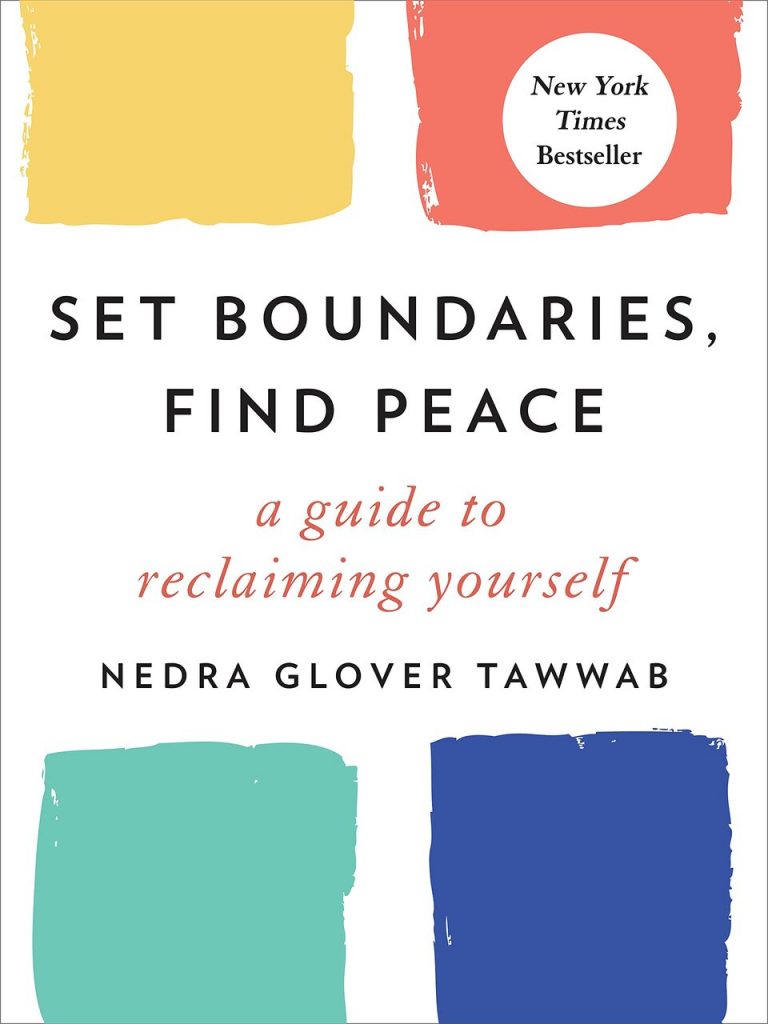“Boundaries are not common sense; they’re taught.”
In Set Boundaries, Find Peace, Licensed counselor Therapist and New York Times Bestselling Author Nedra Tawwab presents simple-yet-powerful ways to establish healthy boundaries in all aspects of life. Rooted in the latest research and best practices used in cognitive behavioral therapy (CBT), these techniques help us identify and express our needs clearly and without apology–and unravel a root problem behind codependency, power struggles, anxiety, depression, burnout, and more.
Boundaries are expectations and needs that help you feel safe and comfortable in your relationships. Expectations in relationships help you stay mentally and emotionally well. Learning when to say no and when to say yes is also an essential part of feeling comfortable when interacting with others.
A boundary is a cue to others about how to treat you. It can be explicit, such as saying “I’m about to share something that I’d like you to keep between just the two of us.” Or implicit, such as having a basket for shoes and socks right by the front door for guests.
“Boundaries are the cure to most relationship problems. But both parties have to participate and respect the boundaries on either side.”
At first, setting your boundaries may be uncomfortable. You might feel riddled with guilt. You might question if you’re doing the right thing. But set them anyway. Push past the discomfort, and do it even while you feel afraid. You’re challenging yourself to be healthier and to have healthier relationships.
Ambivalence is a part of the process, and it’s perfectly natural to feel insecure while trying something new. Then, once you start setting boundaries, stay the course, because consistency is the most crucial part of the process.
Remember: there is no such thing as guilt-free boundary setting. If you want to minimize (not eliminate) guilt, change the way you think about the process. Stop thinking about boundaries as mean or wrong; start to believe that they’re a nonnegotiable part of healthy relationships, as well as a self-care and wellness practice.
The Meaning of Boundaries
- They are a safeguard to overextending yourself.
- They are a self-care practice.
- They define roles in relationships.
- They communicate acceptable and unacceptable behaviors in relationships.
- They are parameters for knowing what to expect in relationships.
- They are a way that you ask people to show up by upholding your needs.
- They are a way to communicate your needs to others.
- They are a way to create healthy relationships.
- They are a way to create clarity.
- They are a way to feel safe.
Signs That You Need Boundaries
- You feel overwhelmed.
- You feel resentment toward people for asking for your help.
- You avoid phone calls and interactions with people you think might ask for something.
- You make comments about helping people and getting nothing in return.
- You feel burned out.
- You frequently daydream about dropping everything and disappearing.
- You have no time for yourself.
Fear
The number one reason that people avoid setting boundaries: fear of someone getting mad at them.
“Fear is not rooted in fact. Fear is rooted in negative thoughts and the story lines in our heads.”
Reasons People Don’t Respect Your Boundaries
- You don’t take yourself seriously.
- You don’t hold people accountable.
- You apologize for setting boundaries.
- You allow too much flexibility.
- You speak in uncertain terms.
- You haven’t verbalized your boundaries (they’re all in your head).
- You assume that stating your boundaries once is enough.
- You assume that people will figure out what you want and need based on how you act when they violate a boundary.
Self-Care
“The root of self-care is setting boundaries”
Self-care is more than taking a spa day, and it isn’t selfish. Saying no to helping is an act of self-care. Paying attention to your needs is self-care. And like putting on the oxygen mask, you’ll havemore energy for others if you apply it to yourself first. If you think about it, the root of self-care is setting boundaries: it’s saying no to something in order to say yes to your own emotional, physical, and mental well-being.
Three levels of boundaries
Porous
Porous boundaries are weak or poorly expressed and are unintentionally harmful. They lead to feeling depleted, overextending yourself, depression, anxiety, and unhealthy relationship dynamics.
Porous boundaries look like
- Oversharing
- Codependency
- Enmeshment (lacking emotional separation between you and another person)
- Inability to say no
- People-pleasing
- Dependency on feedback from others
- Paralyzing fear of being rejected
- Accepting mistreatment
Rigid
At the other extreme, rigid boundaries involve building walls to keep others out as a way to keep yourself safe. But staying safe by locking yourself in is unhealthy and leads to a whole other set of problems. Whereas porous boundaries lead to unhealthy closeness (enmeshment), rigid ones are a self-protective mechanism meant to build distance. This typically comes from a fear of vulnerability or a history of being taken advantage of.
Rigid boundaries look like
- Never sharing
- Building walls
- Avoiding vulnerability
- Cutting people out
- Having high expectations of others
- Enforcing strict rules
Healthy
Healthy boundaries are possible when your past doesn’t show up in your present interactions. They require an awareness of your emotional, mental, and physical capacities, combined with clear communication.
Healthy boundaries look like
- Being clear about your values
- Listening to your own opinion
- Sharing with others appropriately
- Having a healthy vulnerability with people who’ve earned your trust
- Being comfortable saying no
- Being comfortable hearing no without taking it personally
Communication and Action
Whenever you identify a boundary you’d like to set, remember that there are two steps to the process: communication and action.
Communication
Verbally communicating your needs is step one. People cannot accurately assume your boundaries based on your body language or unspoken expectations. When you explicitly state what you expect, there is little room for others to misinterpret what works for you. Assertive statements are the most effective way to do this.
Action
The process doesn’t end with the communication. You must uphold what you communicate through your behavior. Betting on the other person to read your mind is a recipe for an unhealthy relationship.
Signs of an Unhealthy Relationship
- You are unable to express your needs because the other person refuses to listen.
- The other person refuses to meet reasonable requests.
- There’s emotional, physical, or sexual abuse.
- You feel sad, angry, drained, or disappointed after most interactions.
- The relationship is one-sided; you give and they take.
- There’s a lack of trust in the relationship.
- The other person refuses to change some unhealthy behaviors.
- The other person has an addiction that is harmful to you.
“Boundaries grow and expand over time as our needs change.”
Friends are your chosen family, and these relationships should bring ease, comfort, support, and fun to your life—not excess drama.
Boundaries are not unspoken rules.
“People can’t meet a standard that we never express. Boundaries are not unspoken rules.”
Unspoken boundaries are invisible, and they often sound like “They should’ve known better” or “Common sense would say . . .” Common sense is based on our own life experiences, however, and it isn’t the same for everyone. That’s why it’s essential to communicate and not assume that people are aware of our expectations in relationships. We must inform others of our limits and take responsibility for upholding them.
Cutoff
A cutoff is when you abruptly (sometimes without explanation) disconnect from another person. Before you cut people off, ask yourself this:
- Was the other person aware of my issues with the relationship?
- Have I tried setting a boundary?
- Did I uphold my boundary and hold the other person accountable?
Cutoffs happen as a result of believing that the other person is incapable of change, that they won’t honor our boundary, or that we have let things go so far that we’re no longer interested in repairing the relationship. Cutting people off may seem like an easy way to resolve relationship issues, but we can’t escape setting limits if we want healthy relationships.
“The short-term discomfort of setting a boundary isn’t a reason to continue tolerating the longer-term discomfort of the issues that inevitably result. Unhealthy relationships are frustrating and damaging to our long-term well-being. Over time and with consistent practice, setting boundaries becomes easier.”
People Pleasing
People-pleasers tend to be consumed with thoughts about what others are thinking and feeling. They want to appear as good, helpful, and inviting. For people-pleasers, setting a boundary is especially hard because their worst fear is being disliked, on top of the fear of being mean or rude. These fears are often significant enough that people-pleasers would rather suffer in relationships without limits than face their fears.
Enmeshment
In enmeshed relationships, individualization is not acceptable. Neither are boundaries. These relationships thrive on each person being very similar to the other. If one person makes attempts to set limits, create new roles, or shift the dynamics, the relationship is in danger of termination.
This is enmeshment:
- Inability to be different from the other in a relationship
- Lack of individual identity
- Unclear sense of self separate from the other person
- Lack of boundaries
- Confusion between the quantity of time spent together versus the quality of the time spent together
- Oversharing
- Absorbing the emotions of the other person as your own
- Rejection by the other person if you attempt to form an individual identity
Enmeshed relationships violate boundaries in the following ways:
- Little personal space is given, emotionally or physically.
- The thoughts of both people must be aligned.
- Life decisions are based on mutual agreement and no independence of thought.
Codependency
In codependent relationships, we believe we must help people avoid consequences, saving them from unpleasant experiences. We think it’s our role to protect them. But rather than protect, we enable the other person to continue their unhealthy behavior.
The term “codependent” has been around for decades and is often used when describing dysfunctional family dynamics, especially when addiction is involved. But codependency pertains to any relationship where people become emotionally entangled with the feelings and outcomes of others. In codependent relationships, it’s challenging to separate what we feel from what others think and feel.
Boundaries for Codependency
- Set clear expectations with regard to how you can help.
- Provide feedback about how the other person’s behaviors are affecting you.
- Support people without doing things for them.
- Wait for people to ask for help instead of offering before they ask.
- Honor your commitment to yourself about what you will and will not tolerate in relationships.
- Be vocal about toxic behaviors you observe.
- Take care of yourself.
- Hold people accountable for caring for themselves.
- Help while teaching people how to help themselves.
How to Successfully Communicate a Boundary
Step #1
Be clear. Do your best to be as straightforward as possible. Mind your tone—don’t yell or whisper. People will miss the boundary if you use complicated words or jargon. Take a deep, deep breath, and focus on being precise.
Step #2
Directly state your need or request, or say no. Don’t just mention what you don’t like; ask for what you need or want. Identify your expectations, or decline the offer.
Step #3
Dealing with the discomfort that happens as a result of setting boundaries is the hardest part. Discomfort is the number one reason we want to bypass setting them. It’s common afterward to feel guilty, afraid, sad, remorseful, or awkward.
Boundaries with Difficult People
Pushback
They ignore that you mentioned a boundary and continue to do what they want.
Testing Limits
They try to sneak, manipulate, or get one past you. They attempt to do what they want, but in a way you might not notice.
Rationalizing and Questioning
They challenge the reason for your boundary and its validity.
Defensiveness
They challenge what you said or your character, or make excuses about how their behavior is okay.
Silent Treatment
They stop talking to you because they didn’t like what you said. This tactic is used with the hope that you’ll take back your boundary.
Boundary Statements: I Want . . . , I Need . . . , I Expect . . .
The best boundaries are easy to understand. Starting statements with “I need,” “I want,” or “I expect” helps you stay grounded in the truth of who you are.
Follow Up On Your Boundaries with Action
We think stating boundaries is hard, but it’s even harder to uphold them. People get their cues from you. If you ask them to take their shoes off in your house, you have to take your shoes off, too. If you don’t, people will use your behavior as a reason for dishonoring your boundaries. So be an excellent example of the actions you request from others.
Another part of upholding the boundary you’ve set is deciding what you’ll do if it’s violated. If you do nothing, you aren’t honoring your boundary.
Common Reasons People Don’t Respect Boundaries
- You aren’t upholding your boundaries with them.
- You didn’t speak in a firm tone.
- You didn’t state a need or an expectation.
- Your boundaries are flexible. One minute, they’re serious; the next, they aren’t.
- You assume people will self-correct even if you don’t tell them what you need or want.
- You believe that stating your boundary once should be enough.
- You apologize for having boundaries.
- You issue consequences and don’t stick to them.
Quick Tips for Handling Boundary Violations
Tip #1
Speak up in the moment. When you remain silent, you give people the impression that what they said or did is okay with you. What you say doesn’t have to be well-thought-out or perfect. Simply say something like, “I don’t like it.” Saying anything is better than saying nothing.
Tip #2
Verbalize your boundaries with others. Do it organically in conversation, such as “I don’t like it when people come over without calling first.
Tip #3
If someone violates a boundary you’ve already verbalized, tell them how the violation makes you feel. Then restate what you expect.
Tip #4
Don’t let people slide—not even once.
There are five ways to communicate a boundary:
- Passive: Letting it slide.
- Passive-Aggressive: Acting upset without clearly stating your needs to the other person.
- Aggressive: Being rigid, inflexible, and demanding about what you need.
- Manipulation: Coercively attempting to get your needs met.
- Assertive: Telling people exactly what you desire clearly and firmly.
You can’t change people, but you can change
- How you deal with them
- What you accept
- How you react to them
- How often you interact with them
- How much space you allow them to take up
- What you participate in
- What role they play in your life
- What people you have contact with
- Who you allow in your life
- Your perspective
Benefits of Setting Healthy Boundaries
Situations, relationships, and people struggle to survive without boundaries. Here are just a few of the benefits:
- People with boundaries sleep better.
- People with boundaries experience less burnout.
- People with boundaries have healthier relationships that tend to last longer.
- People with boundaries experience less stress.
- People with boundaries feel more joyful.
- People with boundaries benefit from the short- and long-term value of setting them.
All the Best in your quest to get Better. Don’t Settle: Live with Passion.



4 Comments
Pingback: On Complaining. – Lanre Dahunsi
Pingback: On Boundaries. – Lanre Dahunsi
Pingback: Top Quotes on Codependency. – Lanre Dahunsi
Pingback: On Codependency. – Lanre Dahunsi